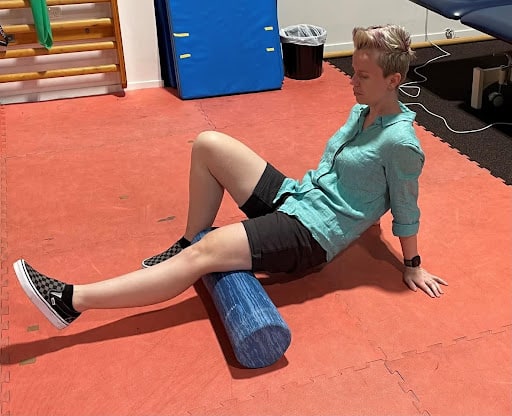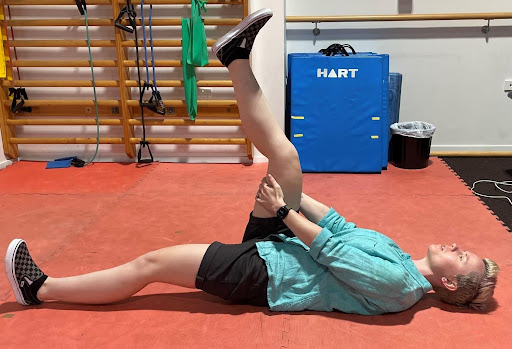
Jess Cadenhead
(MSc Clinical Exercise Physiology, PgDipSci, BSc, Registered Clinical Exercise Physiologist (ACSM, CEPNZ))
Many of us experience issues with our hamstring muscles. This may be muscle tightness to a more severe strain or tendonitis. It is important to understand the risks and recognise common signs and symptoms that may indicate an issue.
Most of the conditions discussed in this article, such as:
- Tight hamstrings
- Hamstring strain
- Hamstring tendonitis
- Proximal hamstring tendinopathy
need to be diagnosed by a medical professional.
As exercise professionals we can only help prevent these issues or help with treatment after the injury through appropriate rehabilitation.
Tight hamstrings
This is the most common issue we experience with our hamstrings.
We live a very sedentary life and due to prolonged periods of sitting and hours with our knees bent, we have shortened the hamstring muscle.
This tightness can lead to compensation through the lumbo-pelvic hip complex and as a result many may experience lower back pain.
RELATED — Relieve back pain: 5 Beginner Yoga Exercises, Stretches and Poses
This tightness also puts the muscle at an increased risk of some of the further complications discussed in this article.
Stretching and even strengthening hamstrings through dynamic movements can help with preventing tightness.
Breaking up long periods of sedentary time (>60mins) is another key tip!
Hamstring strain (torn hamstring)
A hamstring strain or torn hamstring is probably the most common injury for those who engage in sports.[1,2]
It often occurs during sudden, powerful movements, such as jumping, sprinting, and lunging. It can also occur in slower movements when the tendons and muscles have been overstretched.
Those who have suffered a hamstring strain before have a 2.71 higher risk of re-injury.[3]

Symptoms usually involve sudden pain and tenderness at the back of the thigh.
With more severe tears, swelling and bruising may be evident, and it may be difficult to weight-bear on the affected leg.
Hamstring Tendonitis
Hamstring tendonitis is an issue where the tendons of the hamstring muscles have become inflamed, usually because of overuse, but can also occur due to a sudden hamstring injury (a micro tear in the tendon).
Pain, aching, stiffness and swelling, usually in the back of our thigh, close to our hip or knee joint are the common symptoms.
Hamstring tendonitis usually resolves on its own within a few days
However, in cases where you have any of the following, please seek medical help:
- Cannot weight-bear
- Sudden intense leg pain
- Loss of feeling in lower back, buttocks or leg
- Lumps in the thigh
- Severe swelling or bruising at the back of the thigh
Applying R-I-C-E is usually the best at home treatment for minimising pain and swelling in the hamstrings.
- Rest – avoid any strenuous activity like bending the knee or walking too much.
- Ice – apply an ice pack to the back of the thigh for around 20 minutes every 2-3 hours.
- Compression – use a compression bandage or wrap if your health provider says it is safe to do so.
- Elevate – elevate the leg when you can so your knee and thigh are above the level of your heart.
Some exercises can help with the rehabilitation and treatment of this injury, such as hamstring strengthening exercises, pelvic positioning exercises, e.g. dead bug exercise, and glute strengthening exercises.
The key tip to preventing this issue is to ensure our hamstrings and quadriceps are strong. Add in hamstring stretches and rest between periods of intense physical activity.
Proximal Hamstring Tendinopathy
Proximal hamstring tendinopathy is also an inflammation of the tendons at the back of the thigh. It occurs when the tendon is overused or overloaded, and typically is a result of repetitive loading of micro-tears (tendonitis).
The symptoms are similar to that of tendonitis, but is most notable by a constant deep pain in the buttocks area.

The exact cause of tendinopathy is unknown, but some common causes include prolonged running, deep lunges, sprinting, long distance cycling and kicking a ball.
Most people with hamstring tendinopathy pain respond well to conservative management strategies, which includes a progressive, loading exercise programme (designed by a physiotherapist or clinical exercise physiologist).
Research has shown that heavy and slow eccentric hamstring strengthening exercises are most effective for improving tendon structure and repair.[4]
It is also important to strengthen the supportive musculature (glutes, adductors, calves and quadriceps) so they can reduce the forces going directly through the hamstring muscles and tendon.
Preventative Hamstring Exercises
Many of the issues we have discussed in this article can easily be prevented by:
1) Improving hip and knee mobility
2) Improving hamstring tightness
3) Increasing the strength of the hamstrings and surrounding musculature
To improve hip and knee mobility (the two joints the hamstring muscles connect to), and to help with releasing tightness through the hamstrings there are a few things you can do:
- Foam rolling
- Stretching (both static and dynamic)
Foam rolling the hamstrings
The goal of foam rolling the hamstrings is to help with releasing tight muscles and fascia (which surrounds the muscle).
The research is conflicting on whether it is best to do this before or after a workout, but both show improvements in muscle tightness.
Any type of foam roller will work, but if you are new to foam rolling, I would suggest a softer one to start with.
When rolling the hamstrings, you can either do each leg individually or both at the same time. You will find doing it individually will allow you to add more pressure into the rolling.
To foam roll, place the roll below the middle of the muscle belly, and then begin to gently roll along the muscle belly. When you find a tender spot, stop and hold the spot for 10-20 seconds and relax the muscle as much as you can.
Make sure to rotate your leg side to side, to get the whole muscle belly. Foam roll for around 2 minutes, and ideally do this prior to any other exercises.

Hamstring stretches
When it comes to stretching the hamstrings, there are many ways to stretch the hamstrings.
Static Hamstring Stretch
This is one of my favourite hamstring stretches and is one of the simplest for anyone to do.
All you need to do is sit on the floor with one leg straight out in front of you. Bend the other leg at the knee and position the sole of your foot against the inner thigh of your opposite leg.

Once in this position, extend your arms and reach forward over the straight leg and you should feel a stretch through your hamstrings. Hold this position for 20-30 seconds and then repeat on the other side.
Dynamic Hamstring Stretch
Not all stretching is static, and one important factor to think about is every activity we do we are usually moving a muscle and a joint through a large range of motion.
Dynamic stretching is a movement-based type of stretching, where the muscles and joints go through a full range of motion.
For an easy dynamic stretch for the hamstrings, lay down on the floor on your back. Lift one leg up straight until you feel a good stretch in your hamstrings, grab this leg with both your hands to hold it there.

In this position you will start the dynamic movement, which is essentially bending and straightening the leg you are supporting.
Slowly bend the knee and then return it back to the straightened position for about 15-20 repetitions. Switch legs and repeat.

For further hamstring strengthening exercises and strengthening surrounding musculatures, please check out our Activities and Performance page.
RELATED — Exercise Guide to: Hardy Hamstrings
Related Questions
1. What is grade 1 hamstring strain pain?
A grade 1 hamstring strain will usually cause a sudden pain at the back of your thigh.
It may be painful to move the leg, but the strength of the muscle should not be affected. This is typically what we refer to a “pulled” hamstring.
2. What causes chronically tight hamstrings?
Prolonged sedentary behaviour can lead to chronically tight hamstrings.
When seated we have our hamstrings in a shortened position, meaning that over time the muscle becomes tight.
3. Does deficiency in vitamins and minerals cause tight hamstrings and hamstring cramps?
Too little magnesium, potassium, and calcium in the body may produce a hamstring cramp.
However, this will not lead to tight hamstrings. It is important to take these electrolytes to avoid cramps within the hamstrings.
RELATED — Potassium (for blood pressure, heart rhythm and pH balance)
Jess has always been passionate about health and well-being, and for many years now has been helping individuals with chronic conditions on how to use exercise as medicine. Jess is a registered Clinical Exercise Physiologist (ACSM and CEPNZ), where she specialises in providing evidence-based exercise rehabilitation.
Jess is highly passionate about promoting exercise physiology and prescription to different populations, especially those with conditions such as cardiovascular disease, cancer, Parkinson’s and Chronic Fatigue Syndrome.
She has worked in various community roles in the past and has helped develop different community based exercise programmes for Falls Prevention and helped design suitable assessments for those suffering from Post Concussion Syndrome.
Currently, Jess is a Professional Teaching Fellow in the Department of Exercise Sciences at the University of Auckland. She specialises in coordinating and teaching the postgraduate Clinical Exercise Physiology programme.
When Jess is not at work she will most likely be on the football pitch, or at the dog park with her dog, Raven.
You can find Jess at The Health and Rehabilitation Clinic at the University of Auckland.
References
(1) Hägglund, M., Waldén, M., & Ekstrand, J. (2013). Risk factors for lower extremity muscle injury in professional soccer: the UEFA Injury Study. The American journal of sports medicine, 41(2), 327-335.
(2) Bennell, K. L., & Crossley, K. (1996). Musculoskeletal injuries in track and field: incidence, distribution and risk factors. Australian journal of science and medicine in sport, 28(3), 69-75.
(3) Green, B., Bourne, M. N., van Dyk, N., & Pizzari, T. (2020). Recalibrating the risk of hamstring strain injury (HSI): A 2020 systematic review and meta-analysis of risk factors for index and recurrent hamstring strain injury in sport. British Journal of Sports Medicine, 54(18), 1081-1088. Retrieved from https://bjsm.bmj.com/content/54/18/1081?fbclid=IwAR1NbyuM610_UDd8_3mT4UfTIAKJh6eDDJMuv6JI83atyxwfFwkjGL_0_do
(4) Cushman, D., & Rho, M. E. (2015). Conservative treatment of subacute proximal hamstring tendinopathy using eccentric exercises performed with a treadmill: a case report. journal of orthopaedic & sports physical therapy, 45(7), 557-562. Retrieved from https://www.jospt.org/doi/full/10.2519/jospt.2015.5762






